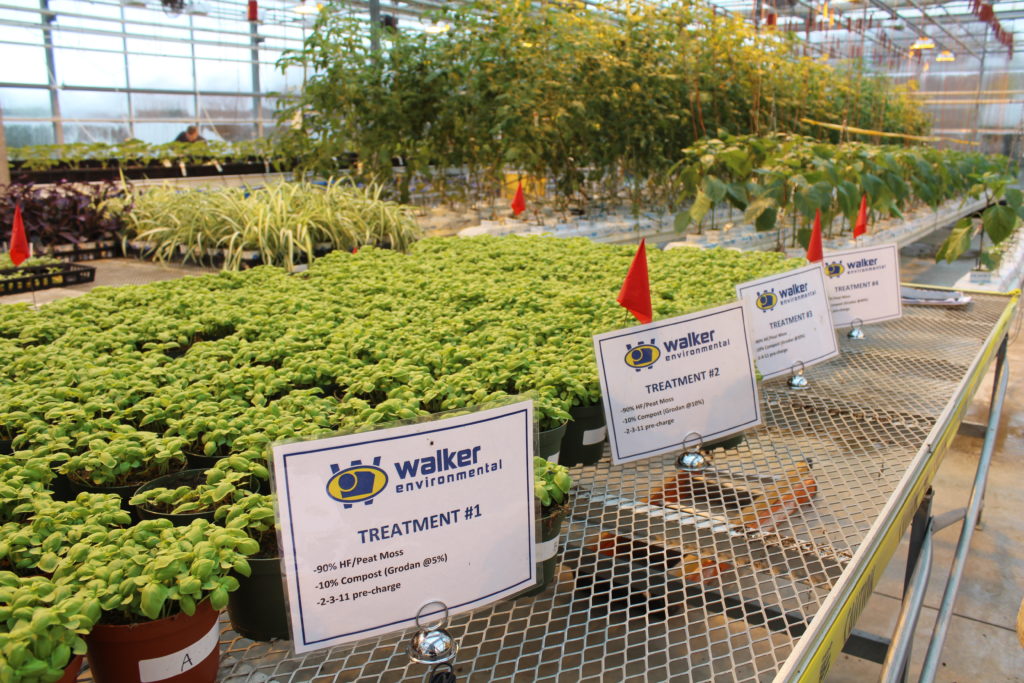
(5-40%) in combination with Walker’s proprietary compost peat blend. No supplemental fertilizers were used.
(Photo courtesy of Niagara College Canada)
Challenge: How best to recycle a non-biodegradable mineral wool product used in greenhouse production? Solution: Test compost production using different mixtures as a bulking agent Impact: Extend life of landfill resources, improve sustainability by recycling of resource
Researchers from Niagara College’s Horticultural & Environmental Sciences Innovation Centre (HESIC) have played an important role investigating uses for a waste product from the greenhouse industry.
The research team with students from the Greenhouse Technician program worked on a course-based growing trial project with Walker Environmental Group (WEG) to explore recycling possibilities and beneficiary secondary uses of rockwool, a non-biodegradable mineral wool product.
An inorganic insulator, rockwool is also manufactured as a soilless growing medium and typically used for hydroponic fruits and vegetables.
“This type of media, which comes wrapped in plastic bags, allows growers to precisely dose fertilizers, water and other components necessary for the most optimal growth of the plants,” says Marin Dujmovic, process specialist at WEG. “Once crops are harvested, this media is not re-usable for growing and needs to be disposed of.”
Walker’s machinery shreds the material, separating plastic bags from the re-usable rockwool. “Once separated, plastic is disposed at the landfill (even though we are looking into re-using this plastic in manufacture of low-carbon fuels etc.) and shredded rockwool material is used as a bulking agent in compost production,” adds Dujmovic.
With its history of offering environmental waste solutions, WEG partnered with HESIC, part of Niagara College’s Research & Innovation division, to investigate the possible benefits of using rockwool as more than just a bulking agent.
“In theory, this bulking agent will increase compost’s moisture content (since we receive rockwool at high moisture levels, with some nutrient leftovers as well), water holding capacity, porosity and nutrients, which all have a beneficial effect on the growth of the plants,” explains Dujmovic.
“The work previously conducted at Niagara College has been instrumental in helping us develop this program as we work to find a suitable means for treating, recycling and creating valuable products from waste growing media,”
~ Greg Robles, manager, Innovation & Optimization Resource Recovery,
Walker Industries
Led by NC faculty research lead Derek Schulze, the growing trial with a basil crop used varying percentages of the rockwool/compost blends, compared with a control, to quantify how the plants grow. Results of this phase will determine if it’s possible and/or beneficial to use the rockwool in compost, not only as a bulking agent, but also as a compost quality enhancer.
“If there’s no impact with the highest percentage, that means they can get rid of tons of rockwool, and the plants grow just fine,” says Schulze, who’s also the coordinator for NC’s Greenhouse Technician program.
If the used rockwool media is successfully incorporated into compost production, it may mean new markets for WEG as they will be “able to recycle new material (used rockwool media) on an ongoing basis with good use of the end product,” adds Dujmovic.
As a result of these growing trials, WEG is now advancing development of its rockwool growing media recycling program. The company has since received funding under the Greenhouse Competitiveness and Innovation Initiative from the Agriculture Adaptation Council to study the market development of rockwool recycling services.
Walker is also working with the Ontario Greenhouse Growers Association to validate composting as a means for effectively destroying pathogens affecting greenhouse grown plants.
“The work previously conducted at Niagara College has been instrumental in helping us develop this program as we work to find a suitable means for treating, recycling and creating valuable products from waste growing media,” said Greg Robles, manager, Innovation & Optimization Resource Recovery, Walker Industries.
This project is funded in part by the Government of Canada through the Federal Economic Development Agency for Southern Ontario.
The HESIC growing trial also received funding from the Ontario Centre of Innovation (OCI) through their College Voucher for Technology Adoption (CVTA) program and the NC-led Greenhouse Technology Network (GTN).
Visit Niagara College’s Horticultural & Environmental Sciences Innovation Centre page to learn more about its resources and capabilities.






